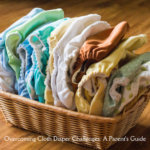As a father of three, my journey through various baby care options has given me a deep insight into the pros and cons of cloth diapering. While cloth diapers are celebrated for their sustainability and cost-effectiveness, they come with their own set of challenges. In this comprehensive guide, we’ll explore the disadvantages of cloth diapers and provide practical solutions to help you make an informed decision that works best for your family and lifestyle.
Recognizing the Disadvantages of Cloth Diapers

Frequent Changes Required
- Issue: Cloth diapers generally have less absorbency than disposables, requiring more frequent changes to prevent discomfort and diaper rash.
- Impact: Increased laundry and potential inconvenience, especially during nights or outings.
Maintenance and Care
- Issue: Cloth diapers demand a significant amount of upkeep including washing, drying, and proper storage.
- Impact: Time-consuming laundry routines and the need for meticulous care to prevent odor and bacterial buildup.
Managing the Extra Laundry Load
Effective Washing Routine
- Establish a consistent schedule for washing cloth diapers every 2-3 days to manage workload and maintain hygiene.
- Use a diaper sprayer to remove solids before storing diapers in a sealed bin to reduce staining and odors.
Choosing the Right Detergent
- Opt for a gentle yet effective detergent that is free from fragrances and fabric softeners to maintain the absorbency of the diapers and protect your baby’s skin.
Time Management Strategies
Streamlining Diaper Changes
- Tip: Set up multiple changing stations in your home to save time.
- Action: Use portable caddies stocked with essentials like wipes and extra diapers to make changes quicker and more efficient.
Bulk Preparation
- Pre-fold or stuff diapers during downtime to speed up changes throughout the day.
- Involve older siblings in preparing diapers, turning it into a learning activity about responsibility and care.
Overcoming Convenience Issues
On-the-Go Solutions
- Invest in a high-quality, odor-controlling wet bag to manage cloth diapers effectively when away from home.
- Plan ahead by packing more diapers than you think you’ll need for outings to avoid running short.
Nighttime Strategies
- Use highly absorbent materials like hemp or bamboo inserts to enhance the absorbency of cloth diapers overnight.
- Consider a wool diaper cover for extra leak protection during long sleep periods.
Financial Considerations
Initial Investment vs. Long-Term Savings
- While cloth diapers require a larger upfront cost, calculate the savings over time compared to disposables to understand the true financial impact.
- Explore secondhand options or cloth diaper services as cost-effective alternatives.
Addressing Health and Comfort Concerns
Preventing Diaper Rash
- Change diapers promptly and ensure thorough cleaning during each change.
- Use natural, breathable fabrics like cotton and bamboo to promote air circulation and reduce moisture buildup.
Sensitive Skin Care
- Choose diapers made from organic fabrics to decrease the risk of allergic reactions.
- Regularly apply a barrier cream that is cloth diaper safe to protect your baby’s skin.
Environmental Impact and Ethical Considerations
Reducing Carbon Footprint
- Emphasize the environmental benefits of reducing landfill waste through reusable diapers.
- Engage in community initiatives or support organizations promoting sustainable diapering solutions.
Making Cloth Diapering Work for You
Despite the challenges, many parents find that the benefits of cloth diapering—both environmental and financial—outweigh the disadvantages. By implementing the strategies discussed, you can enhance your cloth diapering experience, ensuring it is both practical and enjoyable.
Being proactive about managing the disadvantages of cloth diapers ensures that you not only provide the best care for your baby but also contribute positively to environmental conservation. Remember, every small step towards a sustainable lifestyle makes a significant difference. For more insights into making cloth diapering a successful part of your parenting journey, visit ParentingChic.com







